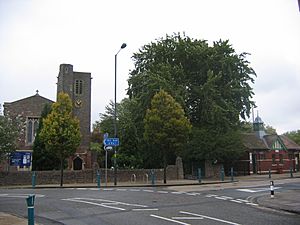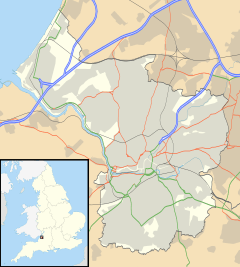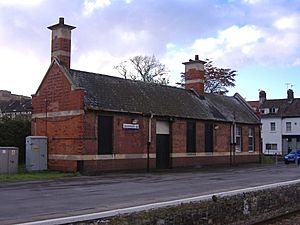Avonmouth facts for kids
Quick facts for kids Avonmouth |
|
|---|---|
 |
|
| Population | 3,402 2011 Census - Avonmouth equates to output areas Bristol 008E and 008F |
| OS grid reference | ST516785 |
| • London | 110 miles (180 km) |
| Unitary authority | |
| Ceremonial county | |
| Region | |
| Country | England |
| Sovereign state | United Kingdom |
| Post town | BRISTOL |
| Postcode district | BS11 |
| Dialling code | 0117 |
| Police | Avon and Somerset |
| Fire | Avon |
| Ambulance | Great Western |
| EU Parliament | South West England |
| UK Parliament |
|
Avonmouth is a busy port town and a part of Bristol, England. It sits on the north side of where the River Avon meets the Severn Estuary. This area is super important for shipping and trade in the region.
Avonmouth Docks is a big part of the Port of Bristol. Huge ships come here to unload and load heavy goods. You'll find lots of industrial buildings, warehouses, and factories in Avonmouth. Major roads like the M5 motorway run through it, and there are train stations on the Severn Beach Line.
Avonmouth is part of the "Avonmouth and Lawrence Weston" area for local government. This area also includes Shirehampton and part of Lawrence Weston.
Contents
Exploring Avonmouth's Location
Avonmouth is shaped a bit like a rectangle. It stretches along the shore of the Severn Estuary. It's on the north bank of the River Avon, to the west of Bristol city centre. Both the river and estuary banks have strong walls built to protect them. These walls also helped build the huge Avonmouth Docks.
What You'll Find Here
Most of the western part of Avonmouth is taken up by these docks. Across the River Avon, you'll find the Royal Portbury Dock. Avonmouth is also home to places that make chemicals. North of the docks, there's a big power station called Seabank Power Station. Many companies have warehouses and light industry here, like Nisbets.
Avonmouth is the only part of Bristol that is west of the M5 motorway. The main living areas are between the industrial zones and the motorway. The Avonmouth Bridge carries the M5 motorway over the River Avon into Somerset. Another motorway, the M49 motorway, starts at the M5 in Avonmouth and goes north to the M4 motorway. This connects to the Second Severn Crossing into Wales. The old Severn Bridge and the M48 motorway are also linked to Avonmouth by the A403. On a clear day, you can even see the Welsh cities of Newport and Cardiff from Avonmouth's coast!
Getting Around Avonmouth
The Portway, which is part of the A4, connects Avonmouth directly to the centre of Bristol. You can also catch a train from Avonmouth railway station, Portway Park & Ride, or St Andrews Road. These trains usually run every hour to central Bristol.
There's even a plan to build a new, very deep container terminal in Avonmouth for even bigger ships.
A Look Back in Time
The area around the mouth of the Avon River was mentioned long ago, even in the Anglo-Saxon Chronicle around the years 915 or 1052. But back then, it wasn't a town, just a place. It was part of a larger area called Shirehampton.
How Avonmouth Grew
In 1860, the city of Bristol built a landing spot at "Avon's Mouth." The name "Avonmouth" as we know it first appeared in 1863. When the Bristol Port Railway and Pier was built in 1865, its final stop was called Avonmouth. A hotel, the Avonmouth Hotel, opened at the same time.
A small new village started to grow to serve the new docks. These docks officially opened in 1877. In the same year, the railway line connected to the main railway network. A new station, "Avonmouth Dock," opened right by the docks.
The new Avonmouth Dock and the first part of the settlement became part of the City of Bristol in 1894. The rest of the growing town joined Bristol in 1904.
Expanding the Docks
Work began in 1902 on a huge expansion of the docks, called the Royal Edward Dock. This was finished in 1908. Because of this expansion, the original train station had to close. From 1902, all trains stopped at Avonmouth Dock station, which was later renamed "Avonmouth" in 1966.
The Avonmouth Hotel stayed open for a while. Many Europeans who were moving to the Americas stayed there before sailing from Avonmouth. During the First World War, it housed women who were part of the army. The hotel was finally taken down in 1926 when the Royal Edward Dock expanded even more.
Between 1919 and 1926, a road called the Portway was built. This made it much easier to drive from Bristol to Avonmouth.
Avonmouth became its own separate parish (a local church area) in 1917. Avonmouth's first church was finished in 1934. Sadly, it was bombed in 1941 during the Second World War by the Luftwaffe. It was rebuilt in 1957.
In December 1971, the M5 motorway reached Avonmouth. It was extended south into Somerset when the Avonmouth Bridge opened in May 1974.
Local Places to Visit
Avonmouth Sewage Works Nature Reserve
The Avonmouth Sewage Treatment Works is a special nature reserve. It's about 10-hectare (25-acre) (that's like 25 acres) and is looked after by Wessex Water. This area has human-made lagoons and a pool. Many birds, like pochard, tufted duck, teal, and shoveler, come here to feed and rest.
The grassy areas are a safe place for small animals like voles and great crested newts. These small animals are sometimes hunted by birds like kestrels and barn owls.
The Range Distribution Centre
Avonmouth is home to the biggest single warehouse building in the United Kingdom! It's operated by The Range and is used as a distribution centre. This huge building covers 1,250,000 square feet, which is about 55 acres of land. It's part of a big project called Central Park, located near the Severn estuary.
How Avonmouth is Governed
Avonmouth is part of the Bristol North West area. This area elects a Member of Parliament (MP) to represent them in the national government.
For local matters, Avonmouth is part of the "Avonmouth and Lawrence Weston" area. This area elects three councillors to the Bristol City Council. Besides Avonmouth, this area includes Shirehampton and part of Lawrence Weston.
Shirehampton is an older part of Bristol with a village feel. It has buildings that are much older than those in Avonmouth. Shirehampton railway station offers train travel to the city centre. The western part of Lawrence Weston crosses into the Avonmouth area, but most of it is in the Kingsweston ward. These combined areas are separated from the rest of Bristol by a small strip of green land, like a buffer zone.
Famous People
The comedian Lee Evans was born in Avonmouth on February 25, 1964.




